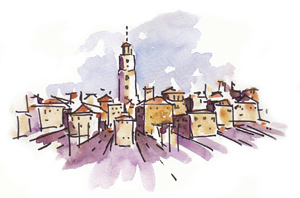 Getting you oriented and helping you stay that way is the first job of wayfinding. You need to know where you are in order to find somewhere else. Many environments have integral orientation features — the church tower in a small town, the central rotunda in a Beaux-Arts museum, even the mountains that define the north edge of Los Angeles or the east edge of Salt Lake City. These dominant features help keep you on track and allow you to ‘direction plan’ with confidence.
Getting you oriented and helping you stay that way is the first job of wayfinding. You need to know where you are in order to find somewhere else. Many environments have integral orientation features — the church tower in a small town, the central rotunda in a Beaux-Arts museum, even the mountains that define the north edge of Los Angeles or the east edge of Salt Lake City. These dominant features help keep you on track and allow you to ‘direction plan’ with confidence.
But many places and buildings lack such iconic elements and you find yourself continually checking the map. Modern buildings, airports and hospitals often lack important passive wayfinding cues. Wayfinding designers specialize in creating and implementing orientation tools such as color systems, sculptural icons and, of course, map directories.

